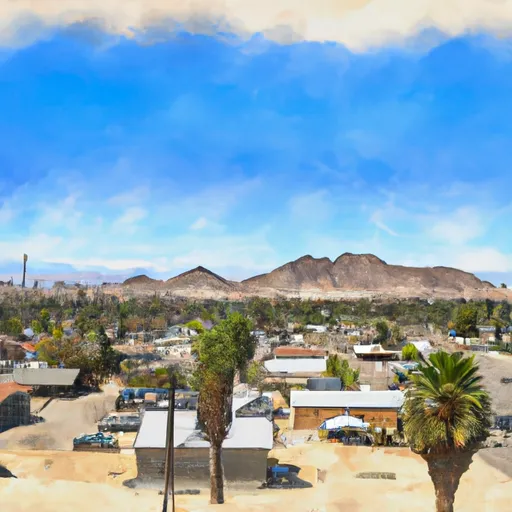-
 Snoflo Premium
Snoflo Premium
Get unlimited access to all our content
With no Ad interruptions! - Start Your Free Trial Login with existing account
Twentynine-Palms
Eden Index
Climate
8.2
•
Recreation
3.9
•
Community
1.9
•
Safeguard
5.1/10

Twentynine Palms, California, located in the Mojave Desert, offers a unique climate and diverse outdoor recreation opportunities. The arid climate of Twentynine Palms is characterized by hot summers and mild winters. Summers experience scorching temperatures reaching over 100°F, while winters are milder with temperatures averaging around 60°F. The region receives minimal rainfall, with most precipitation occurring in the winter months.
In terms of hydrology constituents, the area is known for its desert landscapes and Joshua Tree National Park, which encompasses a significant portion of Twentynine Palms. The park features unique geological formations, including the iconic Joshua Trees and vast expanses of desert flora and fauna. There are also numerous hiking trails, rock climbing opportunities, and camping sites available.
For outdoor enthusiasts, Twentynine Palms provides endless recreational possibilities. Visitors can explore the Joshua Tree National Park, enjoying activities like hiking, mountain biking, bird watching, and stargazing. The region is also renowned for its rock climbing opportunities, attracting climbers from around the world. Additionally, the nearby Mojave Preserve offers further exploration opportunities with its sand dunes, volcanic cinder cones, and Joshua Tree forests. Twentynine Palms is truly a desert oasis for those seeking outdoor adventure and natural beauty.
What is the Eden Index?
The Snoflo Eden Index serves as a comprehensive rating system for regions, evaluating their desirability through a holistic assessment of climate health, outdoor recreation opportunities, and natural disaster risk, acknowledging the profound impact of these factors on livability and well-being.
Climate Health Indicator (CHI): 8.2
Twentynine-Palms receives approximately
118mm of rain per year,
with humidity levels near 60%
and air temperatures averaging around
21°C.
Twentynine-Palms has a plant hardyness factor of
9, meaning
plants and agriculture in this region tend to thrive here all year round.
By considering the ideal temperature range, reliable water supplies, clean air, and stable seasonal rain or snowpacks, the Climate Health Indicator (CHI) underscores the significance of a healthy climate as the foundation for quality living.
A healthy climate is paramount for ensuring a high quality of life and livability in a region, fostering both physical well-being and environmental harmony. This can be characterized by ideal temperatures, reliable access to water supplies, clean air, and consistent seasonal rain or snowpacks.
Weather Forecast
Streamflow Conditions
Southern Mojave
Area Rivers
Southern Mojave
Snowpack Depths
Southern Mojave
Reservoir Storage Capacity
Southern Mojave
Groundwater Levels
Recreational Opportunity Index (ROI): 3.9
The Recreational Opportunity Index (ROI) recognizes the value of outdoor recreational options, such as parks, hiking trails, camping sites, and fishing spots, while acknowledging that climate plays a pivotal role in ensuring the comfort and consistency of these experiences.
Access to outdoor recreational opportunities, encompassing activities such as parks, hiking, camping, and fishing, is crucial for overall well-being, and the climate plays a pivotal role in enabling and enhancing these experiences, ensuring that individuals can engage in nature-based activities comfortably and consistently.
Camping Areas
| Campground | Campsites | Reservations | Toilets | Showers | Elevation |
|---|---|---|---|---|---|
| Belle - Joshua Tree National Park | 18 | 3,858 ft | |||
| Indian Cove - Joshua Tree National Park | 101 | 3,224 ft | |||
| Hidden Valley - Joshua Tree National Park | 44 | 4,222 ft | |||
| White Tank - Joshua Tree National Park | 15 | 3,807 ft | |||
| Cottonwood - Joshua Tree National Park | 62 | 3,069 ft | |||
| Ryan - Joshua Tree National Park | 31 | 4,319 ft | |||
| Jumbo Rocks - Joshua Tree National Park | 125 | 4,347 ft |
Catastrophe Safeguard Index (CSI):
The Catastrophe Safeguard Index (CSI) recognizes that natural disaster risk, encompassing floods, fires, hurricanes, and tornadoes, can drastically affect safety and the overall appeal of an area.
The level of natural disaster risk in a region significantly affects safety and the overall livability, with climate change amplifying these risks by potentially increasing the frequency and intensity of events like floods, fires, hurricanes, and tornadoes, thereby posing substantial challenges to community resilience and well-being.
Community Resilience Indicator (CRI): 1.9
The Community Resilience Indicator (CRI) recognizes that education, healthcare, and socioeconomics are crucial to the well-being of a region. The CRI acknowledges the profound impact of these elements on residents' overall quality of life. By evaluating educational resources, healthcare accessibility, and economic inclusivity, the index captures the essential aspects that contribute to a thriving community, fostering resident satisfaction, equity, and social cohesion.

